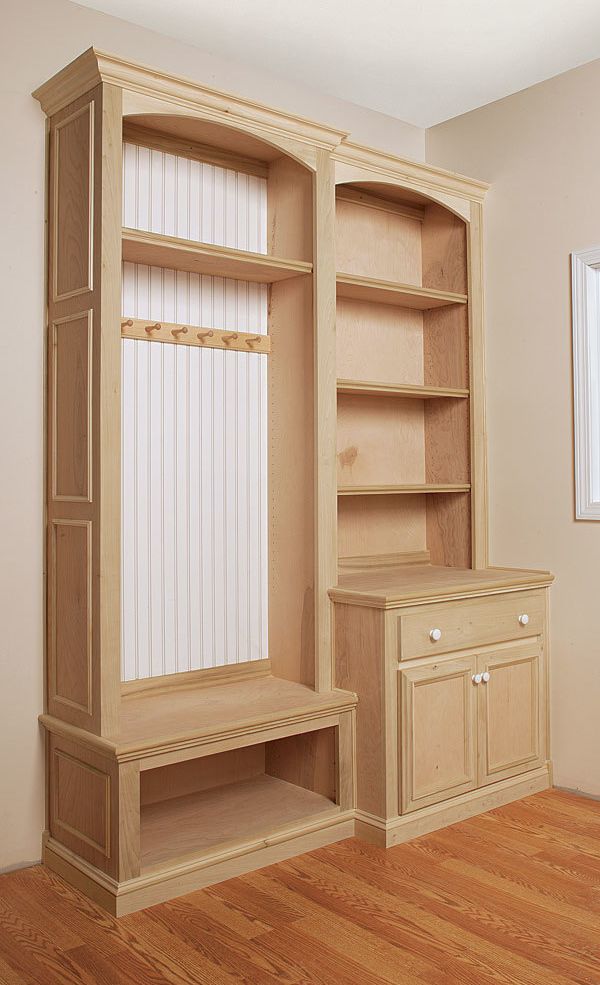Built-ins, Anywhere
Outfit a mudroom with functional storage that looks good enough for any room in the house.

Synopsis: Custom builder Gary Striegler knows a thing or two about built-ins; here, he shows how to construct a mudroom cabinet space with plenty of room for coats, shoes, bags, and more. Made of plywood, MDF, and applied moldings, the cabinet includes pegs for coats, shelves for display items, a bench for sitting, and drawers for storage. Striegler creates a mini-shop on the job site to build this mudroom cabinet; his tool kit includes a track saw, a pocket-hole jig, a miter saw, and a portable planer. Striegler begins by cutting plywood parts to size. He then cuts dadoes in the cabinet sides to house the top and bottom pieces. Next, he assembles the boxes, and assembles and attaches the face frame. Finally, with all the parts cut and assembled, Striegler installs the cabinet from the ground up, making sure that the floor is level and that walls are plumb.
Watch Gary in a mudroom built-in build off with Fine Woodworking‘s Tony O’Malley. The video series provides built-in tips and techniques from each expert.
Even if you live in a place where it’s 80°F and sunny all the time, you probably still need a mudroom. It’s like an air lock in a spaceship, a transition area between the outside and the inside. A well-designed mudroom should have space to store coats, backpacks, boots, and everything else that family members use on a daily basis. It also should be a comfortable place where you can complete the last steps of dressing before facing the outside world.
Mudrooms are usually shared spaces, but when I build them, I like to provide some personal storage space for each family member—and still keep it out in the open. After all, it’s a lot harder to forget something when it’s right in front of you. I also think it’s important to have some concealed storage for things such as umbrellas that you don’t need every day. When shelving is part of my storage design, I make it adjustable. There is no telling what you’ll need to store down the road. Finally, I want every mudroom to have some counter space for things like cell phones, keys, and books.
Built in the shop, on site
When I build a cabinet on site, I use the same basic methods that I would use in a shop. I build the cabinet boxes, attach face frames, then screw the boxes to the wall and to each other. To do this, I employ a few special tools to create a mini-shop. My track saw lets me cut sheet goods in a fairly tight space, and because the saw moves instead of the plywood, it’s a one-man job. When cutting sheet goods with a tablesaw, I need a total of 20 ft. of space. With a track saw, I need about 10 ft. The only drawback is that I have to measure and mark each piece when I’m making multiple cuts.
When I’m building cabinet boxes, accuracy and strength are important. Kreg Tool Company’s Foreman makes fast work of drilling the pocket holes I use for joining cases and face frames. Unlike the company’s pocket-screw jig, this machine is self-contained and drills pilot holes with a lever-actuated indexing mechanism. The screws give me a strong joint without a lot of nail holes on the sides of the cabinet, and they pull the joints tight without clamps. Pocket-screw joints are more efficient than biscuit joints because you machine only one of the two pieces being joined. There are no problems with alignment and there’s no clamp time. As soon as the screw is driven, I can move to the next step.
For more photos and details, click the View PDF button below:
Fine Homebuilding Recommended Products
Fine Homebuilding receives a commission for items purchased through links on this site, including Amazon Associates and other affiliate advertising programs.

Affordable IR Camera

Handy Heat Gun

Reliable Crimp Connectors






















